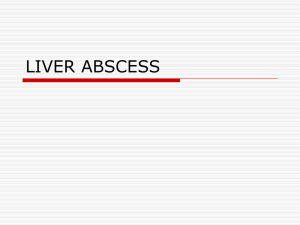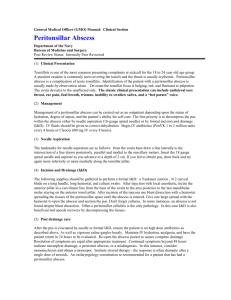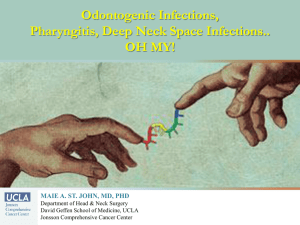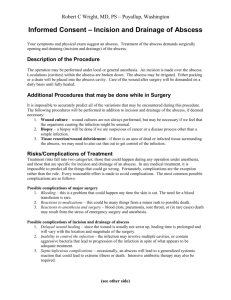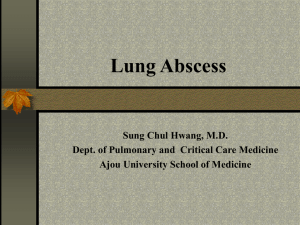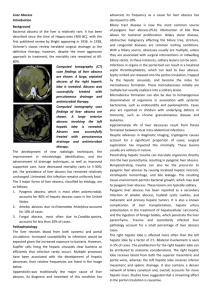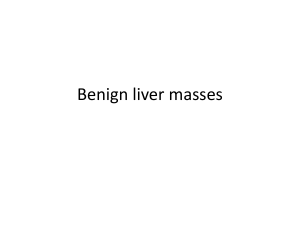GAS FORMING LIVER ABSCESS pak j surgery
advertisement
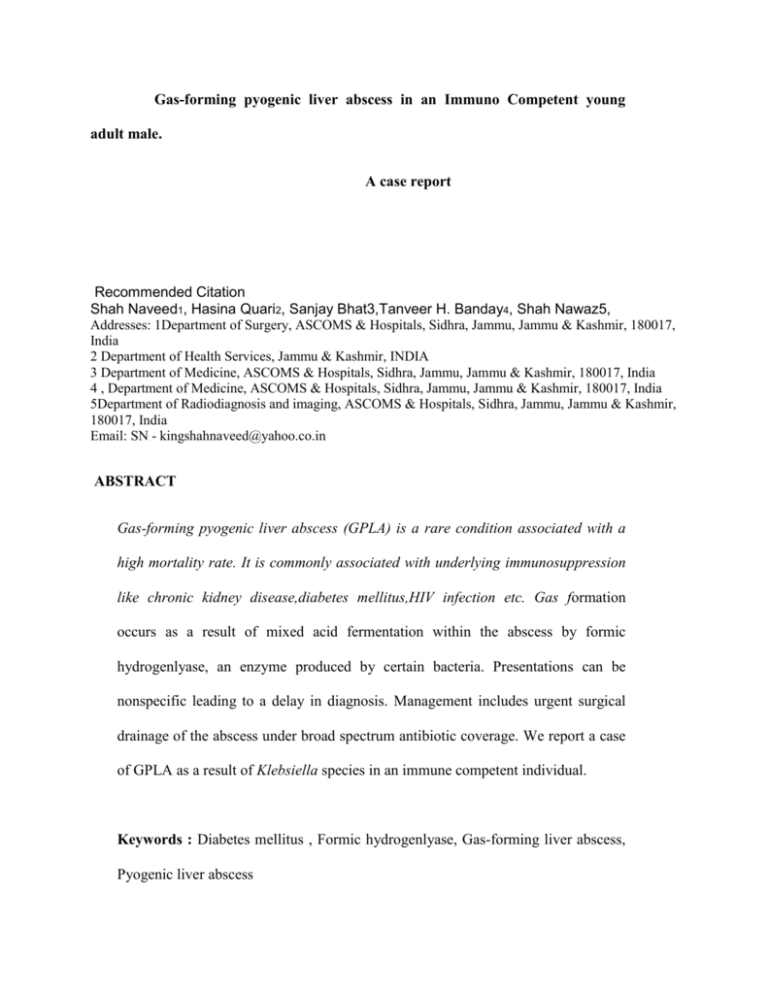
Gas-forming pyogenic liver abscess in an Immuno Competent young adult male. A case report Recommended Citation Shah Naveed1, Hasina Quari2, Sanjay Bhat3,Tanveer H. Banday4, Shah Nawaz5, Addresses: 1Department of Surgery, ASCOMS & Hospitals, Sidhra, Jammu, Jammu & Kashmir, 180017, India 2 Department of Health Services, Jammu & Kashmir, INDIA 3 Department of Medicine, ASCOMS & Hospitals, Sidhra, Jammu, Jammu & Kashmir, 180017, India 4 , Department of Medicine, ASCOMS & Hospitals, Sidhra, Jammu, Jammu & Kashmir, 180017, India 5Department of Radiodiagnosis and imaging, ASCOMS & Hospitals, Sidhra, Jammu, Jammu & Kashmir, 180017, India Email: SN - kingshahnaveed@yahoo.co.in ABSTRACT Gas-forming pyogenic liver abscess (GPLA) is a rare condition associated with a high mortality rate. It is commonly associated with underlying immunosuppression like chronic kidney disease,diabetes mellitus,HIV infection etc. Gas formation occurs as a result of mixed acid fermentation within the abscess by formic hydrogenlyase, an enzyme produced by certain bacteria. Presentations can be nonspecific leading to a delay in diagnosis. Management includes urgent surgical drainage of the abscess under broad spectrum antibiotic coverage. We report a case of GPLA as a result of Klebsiella species in an immune competent individual. Keywords : Diabetes mellitus , Formic hydrogenlyase, Gas-forming liver abscess, Pyogenic liver abscess INTRODUCTION Hepatic abscess described by Hippocrates around 400B.C.either pyogenic or non-pyogenic have uniformly fatal outcome if left untreated . Pyogenic liver abscess (PLA) is a relatively uncommon condition associated with significant morbidity and mortality 1 .Gas-forming PLA (GPLA) is even less common, accounting for 7%–24% of all PLA(2). Pyogenic liver abscesses occur more frequently in adults with comorbid conditions like diabetes mellitus, cirrhosis, pancreatitis, inflammatory bowel disease, pyelonephritis, and peptic ulcer disease. Portal, traumatic, and cryptogenic hepatic abscesses are solitary and large, while biliary and arterial abscesses are multiple and small .Patients with GPLA are often sicker and have higher mortality rates. Despite the recommended aggressive approach to treatment, mortality rates throughout the mid twentieth century remained high at 60-80%. Advances in diagnostic and therapeutic radiology, coupled with improvements in microbiological identification and therapy, have recently decreased mortality rates to <5-30% [6]. Most reports on GPLA have come from the East where the organism most commonly associated with both PLA and GPLA is the Klebsiella spp(2). We report a case of GPLA in an immunocompetent young patient who died following multi organ dysfunction syndrome and septic shock despite all resuscitative measures because of the delay in presentation. CASE REPORT A 34-year man, admitted with a 10 day history of fever(102-103F), vague epigastric pain since 1week, generalised weakness and loss of appetite for 1 week. He had a past history of one attack of acute cholecystitis two and a half month back when ultrasound scan of abdomen had revealed contracted GB(gall bladder) with multiple calculi within, and an isoechoic mass seen in right lobe of liver about 5.1cmx4.1cm, pericholecystic fluid suggestive of acute cholecystitis and liver abscess. He was treated conservatively for acute cholecystitis and discharged after 5 days with advise to continue on oral antibiotics for 4 wks. Patient remained symptom free till he presented to us during the intervening period. On examination, he was Ill-looking , dehydrated, pulse 116 beats/min, blood pressure 80/56mmHg, pallor present, no cyanosis, jaundice was present , no lymphadenopathy, no pedal edema . His abdomen was soft, non-distended, with tender hepatomegaly,liver was palpable 2 finger breadths below the right costal margin in right midclavicular line, no signs of peritonitis or ascites. He was resuscitated with intravenous fluid, and broad spectrum intravenous antibiotics (tazobactum pippercillin and metronidazole). His B.P was brought upto 110/76mmhg after resuscitation with I.V. fluids. In the mean time investigations ordered revealed mild anaemia (10.0 g/dL),leucocytosis (17200/dL), [neutrophils88%, eiosinophils01%, lymphocytes 09%, monocytes02%], platelets 1.6 lacs/mm3, hypoalbuminaemia (1.5 g/dL)totalserum proteins 6.1gm/dl, serum bilirubin total 12.5 mg/dl, serum bilirubin conjugated 7.5 mg/dl, AST 1312 U/L, ALT 381 U/L, ALP 710 U/L, serum sodium 138 meq/l, serum potassium 4.1 meq/l, serum glucose 70mg/dl, serum urea 60mg/dl, serum creatinine 1.6mg/dl, C-reactive protein (33.9 mg/dL) and erythrocyte sedimentation rate of > 150 mm/hr, PTI 72%. Ultrsound scan of abdomen showed a large hypoechoic lesion in right lobe of liver with area of breakdown and echogenic foci (suggestive of liver abscess with air loculi in it ). Computed tomography (CT) confirmed the presence of a large gas forming liver abscess in segment IV and V measuring 10 cm × 8 cm × 11 cm in the right lobe (Fig. 1 & 2 ). Percutaneous aspiration was done whic showed yellowish pus . Pus culture was sent. It showed growth of klebsella pneumonia after 48 hrs of incubation. Blood culture also grew klebsella spp. Amoebic serology was negative. Patient was managed in emergency department with broad spectrum antibiotics ( tazobactum pippercillin and metronidazole) when on 5th day of admission patients BP dropped to 76/50 mmHg. He was infused with 1L of i.v. fluids but his B.P failed to rise. He was shifted to intensive care unit were dopamine infusion was started on 5 micro gms/kg/min which was gradually increased to 20 micro gms/kg/min,as his B.P was not stabilised, noradrenaline infusion was also started at 5 micro gms/kg/min but still his B.P. was not stabilised. He was probably in septic shock and his condition was doomed unfit for any surgical intervention. He had to be intubated on inotropics support. He developed multiorgan dysfunction syndrome and eventually succumbed on 9th day of admission in intensive care unit despite aggressive resuscitative measures. DISCUSSION Pyogenic liver abscess is a relatively uncommon but important disease category. The incidence of pyogenic liver abscess ranges from 8 to 20 cases per 100,000 hospital admissions, usually affecting the elderly [6] . Possible routes of infection include: the biliary tree; the portal vein; the hepatic artery; direct extension from contiguous structures; penetrating or non-penetrating trauma to the liver; and cryptogenic [5,6] . Pyogenic abscesses can be single or multiple. The right hepatic lobe, as in this case, is more commonly involved than the left . Biliary system infection is the most common cause of pyogenic liver abscess and is generally associated with multiple lesions, whereas abscesses arising via the portal vein are usually solitary [5 ] Although the incidence of pyogenic liver abscess has remained relatively unchanged over time, the underlying aetiology has changed in unison with developments in surgical and microbiology practices. Biliary tract disease has replaced appendicitis as the commonest cause of bacterial liver abscess [7]. Chole(docho)lithiasis, obstructing tumours, strictures, and congenital anomalies of the biliary tree, are common causative conditions. An alternative mechanism for liver abscess formation, apart from direct spread from contiguous infection, is embolisation of a septic coagulum from an intra-abdominal infection. Diverticulitis, inflammatory bowel disease and perforated hollow viscera are possible sources of septic emboli in addition to appendicitis. Rarely, abscess formation results from haematogenous dissemination of organisms in association with a systemic bacteraemia, e.g. from endocarditis or pyelonephritis. Such cases have been reported in immunocompromised individuals with chronic granulomatous disease and leukemia [8]. Gas-forming pyogenic liver abscess (GFPLA), which accounts for 7 to 24% of pyogenic liver abscess , has a high fatality rate in spite of aggressive management (27.7 to 37.1%) . This is less than what was reported by Lee et al.(2) Apart from the Klebsiella spp, other organisms reported to cause GPLA include E. coli, Salmonella and Clostridial infections.(4) Common presentations include fever and abdominal pain, but can be nonspecific, resulting in a delay of diagnosis. The production of gas occurs as a result of mixed acid fermentation within the abscess. The mechanism involves fermentation by formic hydrogenlyase, an enzyme that is only produced in an acidic environment when the local pH reaches 6 or less as a result of acid accumulation. Formic acid accumulated within the abscess is converted to carbon dioxide and hydrogen gas by formic hydrogenlyase. (2) The organisms reported to produce this enzyme include Klebsiella spp. and E. coli. Hyperglycaemia is an important factor and poor glycemic control leads to compromised immunity, neutrophil dysfunction and chemotaxis dysfunction. This provides a favourable microenvironment for rapid growth and vigorous metabolism of the organisms, leading to gas formation. Poor microcirculation in the affected areas has also been postulated to contribute to gas accumulation. This may explain the reason for higher incidence of GPLA in patients with DM.(7) Diagnosis can easily be made with radiological imaging. Radiographs may show pockets of gas within the liver parenchyma, but this has been reported to be visible in only up to 36% of patients with GPLA.(2) It is dependent on the amount of gas accumulated, and unless suspected, this may be mistaken as bowel gas. USG(ultrasound) is useful, but CT(computed tomography) is the most sensitive test.. Two large case series studies from Taiwan which involyed 28 and 83 patients with GPLA, respectively, showed a statistically higher incidence of septic shock, bacteraemia and mortality in patients with GPLA compared to non- GPLA patients.(3,4) Surgical drainage has been shown to be very effective particularly for large abscesses.(10) Surgery has been shown to be associated with lower mortality compared to medical treatment and/or aspiration of the liver abscess. However, surgery requires expertise and also depends on the practice of the surgical department. Untreated, pyogenic hepatic abscess is uniformly fatal due to ensuing complications such as sepsis, or peritonitis secondary to rupture of the abscess cavity into the pleural or peritoneal cavities. Systemic antimicrobial therapy remains the mainstay primary treatment. The choice of empiric antibiotics is based on the most likely source of infection, but should be broad spectrum and administered parenterally. The regimen must be reviewed and altered, if appropriate, to target specific organisms isolated from the abscess aspirate and/or blood cultures. The recommended duration of parenteral antibiotic therapy is 2-3 weeks, or until there is a favourable clinical response. Complementary oral antimicrobial therapy must then be continued for a further 2-4 weeks or until clinical, biochemical and radiological follow-up demonstrates complete resolution of the abscess cavity. Evidence suggests that antibiotic therapy alone is usually not sufficient to entirely resolve a liver abscess unless it is small (<3 cm) [9] There is debate however as to the size of abscess above which antibiotic treatment alone is unlikely to be successful. Malik et al recently reported their experience of managing 169 pyogenic liver abscesses, 16 of which were treated with intravenous antibiotics alone for 2 weeks. This conservative approach was successful in only 6 of the 16 patients; the remaining 10 required open surgical drainage for definitive control of sepsis. The authors' criteria for choosing antibiotics as the single therapeutic modality were an uncomplicated abscess, <6 cm in size. The authors' low success rates with this approach provide support for draining abscesses smaller than 6 cm, as recommended by Krige et al [6]. In addition to abscess size, other criteria for percutaneous drainage include: continued pyrexia after 48-72 h of adequate medical treatment, and clinical or ultrasonographic features suggest impending perforation . Surgical drainage is associated with high therapeutic success rates, and was the standard of care until the introduction of percutaneous drainage techniques in the mid 1970s. With refinement of image-guided techniques in recent years, percutaneous drainage and aspiration have emerged as appropriate alternatives to open drainage, providing similarly high success rates but with the advantages of a minimally invasive approach[10]. The decision to leave a drainage catheter in the abscess cavity following aspiration, rather than performing repeated needle aspirations, is also contentious. Those who prefer multiple aspirations believe it to be as effective and safe as catheter drainage, but simpler and quicker to perform, with decreased risk of procedural complications and post-procedural sepsis [10]. However, this approach requires careful followup, and often multiple repeat imaging procedures to monitor response to therapy. Insertion of a drainage catheter has been shown to be more effective than needle aspiration, particularly for abscesses larger than 5 cm. Failure rates are higher, and the average time to achieve a 50% reduction in size of an abscess cavity has been shown to be significantly longer, with needle aspiration compared to abscesses in which a drainage catheter has been placed [10]. Despite the reported success of percutaneous drainage techniques, there remains a role for open surgical intervention in the management of pyogenic abscess. Indications for surgical intervention include: ■ No clinical response after 4-7 days of drainage via a catheter placed in the abscess cavity. ■ Multiple, large, or loculated abscess ■ Thick walled abscess with viscous pus ■ Concurrent intra-abdominal surgical pathology. . Very recently, it has been shown that using multi-detector CT to analyze abscesses could identify factors predictive of percutaneous drainage failure [11]. The strongest predictor of failure included the presence of gas in the abscess. Other notable factors were an abscess size greater than 7.3 cm, and a short length to the liver capsule of <0.25 cm. In the setting of failed percutaneous drainage of a liver abscess, another consideration prior to proceeding with open surgery is laparoscopic drainage. In conclusion, our case highlights that GPLA can also occur in patients who are non-diabetic. These patients are often sicker and require urgent drainage of the abscess. It is very important to perform imaging studies early to reach a diagnosis, as GPLA is still associated with a high mortality. Figure 1 Figure 2 Figure 3 References 1. Johannsen EC, Sifri CD, Madoff LC. Pyogenic liver abscess. Infect Dis Clin North Am 2000; 14:547-63. 2. Lee HL, Lee HC, Guo HR, Ko WC, Chen KW. Clinical significance and mechanism of gas formation of pyogenic liver abscess due to Klebsiella pneumoniae. J Clin Microbiol 2004; 42:2783-5. 3. Lee TY, Wan YL, Tsai CC. Gas-containing liver abscess: radiological findings and clinical significance. Abdom Imaging 1994; 19:47-52. 4. Hayashi Y, Uchiyama M, Inokuma T, Torisu M. Gas-containing pyogenic liver abscess--a case report and review of the literature.Jpn J Surg 1989; 19:74-7. 5.Brook I, Frazier EH. Microbiology of liver and spleen abscesses. J Med Microbiol 1998;47:1075-80. 6. Huang CJ, Pitt HA, Lipsett PA, Osterman FA Jr, Lillemoe KD, Cameron JL, Zuidema GD: Pyogenic hepatic abscess. Changing trends over 42 years. Ann Surg 1996, 223(5):600-607. 7. Branum GD, Tyson GS, Branum MA, Meyers WC: Hepatic abscess. Changes in etiology, diagnosis, and management. Ann Surg 1990, 212(6):655-662. 8.Rahimian J, Wilson T, Oram V, Holzman RS: Pyogenic liver abscess: recent trends in etiology and mortality. Clin Infect Dis 2004, 39(11):1654-1659. 9.Chung YF, Tan YM, Lui HF, Tay KH, Lo RH, Kurup A, Tan BH: Management of pyogenic liver abscesses – percutaneous or open drainage? Singapore Med J 2007, 48(12):1158-1165. 10.Zerem E, Hadzic A:. Sonographically guided percutaneous catheter drainage versus needle aspiration in the management of pyogenic liver abscessAJR Am J Roentgenol 2007, 189(3):W138142. 11. Liao WI, Tsai SH, Yu CY, Huang GS, Lin YY, Hsu CW, Hsu HH, Chang WC: Pyogenic liver abscess treated by percutaneous catheter drainage: MDCT measurement for treatment outcome. Eur J Radiol 2011.
